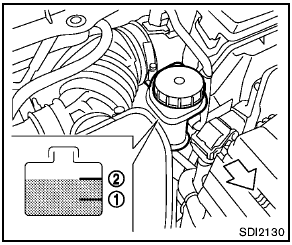Brake fluid
For additional brake fluid information, see “Capacities and recommended fuel/lubricants” in the “9. Technical and consumer information” section of this manual.

- Use only new fluid from a sealed container. Old, inferior or contaminated fluid may damage the brake system. The use of improper fluids can damage the brake system and affect the vehicle’s stopping ability.
- Clean the filler cap before removing.
- Brake fluid is poisonous and should be stored carefully in marked containers out of the reach of children.

Do not spill the fluid on any painted surfaces. This will damage the paint. If fluid is spilled, immediately wash the surface with water.

Check the fluid level in the reservoir. If the fluid is below the MIN line 1 or the brake warning light comes on, add Genuine NISSAN Super Heavy Duty Brake Fluid or equivalent DOT 3 fluid up to the MAX line 2 . If fluid must be added frequently, the system should be checked by a NISSAN dealer.
See also:
Anti-lock Braking System (ABS)
- The Anti-lock Braking System (ABS)
is a sophisticated device, but it
cannot prevent accidents resulting
from careless or dangerous driving
techniques. It can help maintain
vehicle cont ...
Locking with key
The power door lock system allows you to lock or
unlock all doors at the same time.
Turning the key toward the front 1 of the vehicle
locks all doors.
Turning the key one time toward the rear 2 ...
Daytime running light system (Canada only)
The headlights automatically illuminate at a reduced
intensity when the engine is started with
the parking brake released. The daytime running
lights operate with the headlight switch in the
O ...
